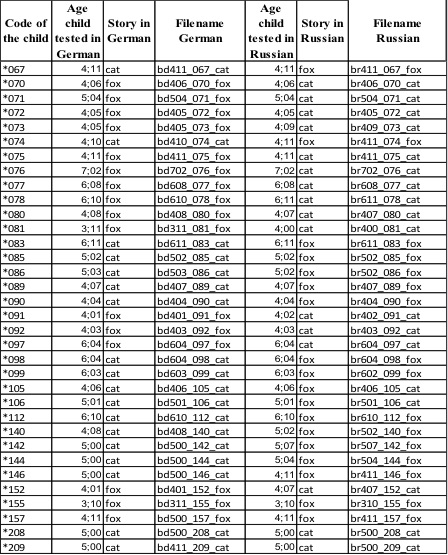
Natalia Gagarina
Leibniz-Centre General Linguistics (ZAS)
gagarina@leibniz-zas.de
website
 |
Natalia Gagarina Leibniz-Centre General Linguistics (ZAS) gagarina@leibniz-zas.de website |
| Participants: | 80 |
| Type of Study: | storytelling |
| Location: | Germany |
| Media type: | audio only for Russian |
| DOI: | doi:10.21415/T5C328 |
Researchers using this database should cite the publications listed below and send a copy of the article to the email address gagarina@zas.gwz-berlin.de .
Gülzow, I. & Gagarina, N. (2007). Noun phrases, pronouns and anaphoric reference in young children narratives. ZAS Papers in Linguistics, 48, 203-223.
Armon-Lotem, N., Gagarina N., Altman C., Burstein-Feldman Z., Gordishevsky G., Gupol O. & Walters J. (2008). Language Acquisition as a Window to Social Integration among Russian Language Minority Children in Israel. Israel Studies in Language and Society 1 (1), 155-177.
Gagarina, N. (2012). Elicited narratives of early Russian-German sequential bilinguals. In: K. Braunmüller and Ch. Gabriel (Eds.). HSM 13, "Multilingual Individuals – Multilingual Societies" Benjamins Publishing Company, Amsterdam, 101-119.
Tribushinina, E., Valcheva, E. & Gagarina, N. (2017). Acquisition of additive connectives by Russian-German bilinguals: A usage-based approach. In: J. Evers-Vermeul, Raiser, L., Tribushinina, E. (Eds.), Usage-based Approaches to Language Acquisition and Language Teaching, 207-234. Berlin: De Gruyter.
In accordance with TalkBank rules, any use of data from this corpus must be accompanied by at least one of the above references.
The database contains transcripts of the audio-records from the experimental study of Russian-German bilinguals’ narratives. This database is a part of a large study on acquisition of discourse coherence devices by monolingual and bilingual children.
80 Russian-German sequential bilinguals (age range: 3;11-7;02 years old) living in Berlin (Germany) and attending a kindergarten / elementary school. Children were all assigned pseudonyms. The files are named by language tested, age of child, code of a child and story used for test # br501_002_fox.cha (See Table of contents in Appendix 1). More information about the bilinguals participated in the study see in (Gagarina 2012).
Two picture stories – the Fox story (developed in by the acquisition research group of the ZAS (Berlin) headed by Dagmar Bittner; first published in Gülzow & Gagarina 2007) and the Cat story (Hickman 2003) were used to elicit children’s narratives (see pictures in Appendix 2). Children were tested in both languages (using two different stories), with a minimum interval of two weeks. The stories were elicited by native speakers of the respective language according to the procedure as in (Gülzow & Gagarina 2007). The procedure is as follows: the investigator asks the child to tell “the story in pictures” and places all pictures one after another on the table in front of the child. After the child has looked through all the pictures and has positively answered to the question Did you understand the story?, the experimenter puts all pictures away and places only the first picture in front of the child and says: “Please, start telling me the story”. When the child has finished with the first picture, the experimenter places the second picture near the first one so that the child sees two pictures and the same time. When the child has finished with the second picture, it is placed on the top of the first picture and the experimenter places the next picture next to the visible second picture which the child has just described. The experimenter refrained from asking questions like What’s this? in order not to provoke naming. Instead, the experimenter encouraged the participants to narrate by asking questions like What’s happening now? and How does the story continue?
Gems are marked as 01, 02, 03, 04, 05, and 06 for the segments of the pictures.
The child and the investigator had a mutual attention situation in which they both see the pictures.



The data collection and processing was supported by the Federal Ministry of Education and Research (Germany) grant № 01UG0711, grant 01UW0702 awarded to Sharon Armon-Lotem, Joel Walters (Bar Ilan University) and Natalia Gagarina (Center for General Linguistics, ZAS) to the Project “Language acquisition as a window to social integration among Russian language minority children in Germany and Israel” and a Marie Curie IRSES grant within the 7th European Community Framework Programme, grant № 269173 “Discourse coherence in bilingualism and SLI” awarded to Elena Tribushinina (Utrecht University) and Natalia Gagarina (Center for General Linguistics, ZAS).
The scrupulous work of Julia Puzanova in editing the files and checking the format made the data available for CHILDES.